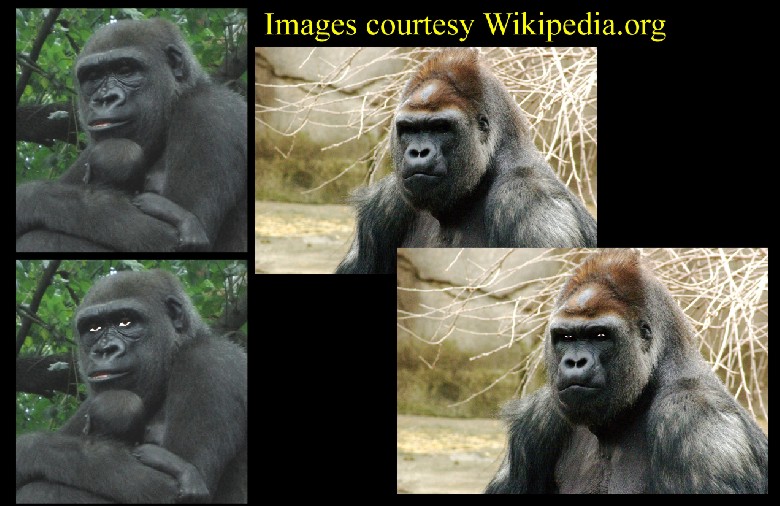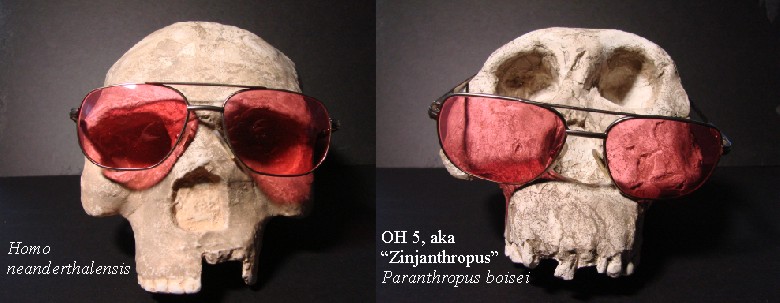The continuing saga of the January 2009 Scientific American “The Evolution of Evolution” special edition – see bottom of page to links to the other commentaries.
“From Atoms to Traits” is the next article in the magazine, for which there’s really not a whole lot to say. It is the typical “Open by stating evolution is a fact, go into a whole pile of science speak, close by pointing out that evolution is a fact, go home and get a coffee.” The majority of the article is interesting, informative, and true. The majority of the article has nothing to do with evolution. But there’s one twist prevalent throughout the article:
The author of this SciAm segment, David Kingsley, (professor of developmental biology at Stanford) starts this segment off with the brazen (and flat-out false) claim that “Modern scientists are revealing how that diversity arises from changes to DNA and can add up to complex creatures or even cultures.” (emphasis mine)
 Let me simply respond to this opening statement by referring you to an excellent book, but it’s a book not for the faint of heart. It’s very technical, although Dr. Sanford did an excellent job of explaining complicated genetics in fairly simple terms – but even then it’s still a tough read for most.
Let me simply respond to this opening statement by referring you to an excellent book, but it’s a book not for the faint of heart. It’s very technical, although Dr. Sanford did an excellent job of explaining complicated genetics in fairly simple terms – but even then it’s still a tough read for most.
“Genetic Entropy” is a compilation of the results of some of the latest research in genetics. The gist of the book is this: The DNA of all of life is deteriorating.
In other words, scientifically speaking, life is losing complexity, not gaining it, as is required by evolution, and falsely claimed in the SciAm article.
Kingsley is correct in saying that changes in the DNA are adding up, however, they are adding up to larger and larger accumulations of errors. Think about it this way: Take a telephone book, or a dictionary. Either one contains a lot of information. Now randomly remove or add random letters throughout the book.
Does such action add to, or take away from, the information?
The answer is obvious: You lose information. Adding letters does not add information, and obviously taking them away does not add information. Now if you used your intelligence to add letters, then yes, you could add information, but evolution is anathema to intelligence. Evolution operates with no intelligence, but uses a whole lot of blind luck – while simultaneously claiming that blind luck somehow formed the seeing eye!
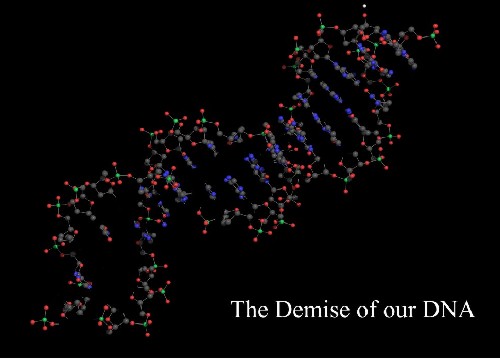 Now back to the genome: We are accumulating random errors in our DNA (the genome), which is the blueprints on how to build you, or a fish, or a tree, etc…
Now back to the genome: We are accumulating random errors in our DNA (the genome), which is the blueprints on how to build you, or a fish, or a tree, etc…
The rates of accumulation for these errors (and loss of information) in the DNA have effectively sealed our “doomsday” for us. In fact, these rates are so high, that it’s alarming.
That doomsday may be hundreds, perhaps even thousands of years down the road, but it does tell us one thing:
We have not been around for millions of years.
For example, read A.S. Krondashov’s 1995 article, “Contamination of the genome by very slightly deleterious mutations: Why have we not died 100 times over?” (Journal of theoretical biology, 175::583-594)
Presumably these observed mutation rates have been going on since the beginning of man. We’re concerned about how much longer we’ve got as a human race, because these mutation (error) rates are so high. So just how have we survived millions of years? I’d suggest we haven’t – we’ve only been around for a few thousand years, and the creation was “perfect” at the beginning, and is deteriorating. But, I’m just a cooky creationist – what do I know.
It also means that we are losing complexity, not gaining it. Our DNA is disingtegrating.
In his article, it appears Dr. Kingsley doesn’t clue in to the significance of what we’re talking about here. On page 55, first paragraph, he says:
“Absolute rates of mutation differ in different species by typically average 10-8 per nucleotide per generation for single base-pair substitutions.”
Doing the math on a 3.2 billion base pair DNA of a human, that’s roughly 32 errors per generation. While this number alone spells doom for humans, the numbers are actually considerably higher. According to Krondoshov, the number is actually between 100 and 300 per generation, and that’s just for the germ (reproductive) cells!
What does that mean? Let me put it to you in terms of a book. We’re going to make a copy of a book that has 3.2 billion letters in it, but replace 32 random letters in the book everytime we make a copy of it. We then take the copy, make a copy of it, adding another 32 random mistakes into it, and so on. How many times can we make these copies before the book becomes unreadable? You see what I’m getting at here: The book will be useable for a while, but continually degrading – eventually getting to the point where it is unreadable.
‘Beneficial’ errors:
There is another error Kingsley makes, and that is the assumption that variation is the result of mutations (errors) in the DNA.
Errors in the DNA (mutations) are not good! For every ‘beneficial mutation’, there are literally millions of neutral to negative mutations – which are preserved and add to a whopper of an error load in the DNA. Yet throughout his entire article, Kingsley props up mutations as the incredible source for the variation of the species!
Now some have claimed that genetic errors have caused a benefit for an organism. While there has been a few cases of arguable benefits from these errors in the DNA, they are exceedingly few, and far between. Also, without exception, every single one of those cases was a loss of information, and a loss of variation with the species.
The variation in the DNA (such as change in hair colour, etc…) are simply programmed into the genes. These variations are not the result of errors, in fact the errors are the source of destruction for the DNA.
A classic example are bacteria that somehow “evolved” to be able to digest nylon. As it turns out, it appears that this is a preprogrammed function in the bacteria (see Don Batten’s article on the AIG website).
The Human Pedigree:
You can’t have good evolutionary propaganda without the nice, fictitious diagrams of ape to man. So SciAm makes sure to not disappoint us. One thing that’s humorous is that I regularly quote a previous SciAm article where the author wrote “The fossils are set in stone, their interpretation is not.” But when it comes to evolution, the fossils are worth far more than their weight in gold, and if you were to weigh the claims made of these fossils, the claims would probably outweigh the fossil itself ten to one!
I’ll address some of the fossils specifically, but first, a quick crash course in identifying fossils.
Ape/human comparisons:
There are numerous differences between ape and human skulls that allows for identification. There are some wildcards though: Let us not forget the incredible variation that can occur within a species (see part 1 of this commentary). Humans and Apes are no exception. Furthermore, the fossil record is one of extinction, and thus we could have a wide variety of apes in the fossil record that are not around today. Furthermore, fossils are typically found crushed, fragmented, or incomplete. There is a lot of room for error, interpretation, and bias. Also, evolutionists (who do most of the digging for said fossils) have preconceived notions about what to find, and can literally mix human and ape fossils together into composite skeletons making true “ape-men”… that never actually existed. Lastly, a little known fact is giantism in the fossil record: Most (if not all) lifeforms had larger representatives in the past then they have today.
These factors alone have a heavy influence on our interpretation of fossils, and the potential for misidentification of fossils.
One difference between apes and humans is the shape of the jaw.
(Original images from “Science vs. Evolution handbook“)
As you can see, apes have a “U” shaped jaw, while humans have a parabolic shaped jaw. Seeing as how evolution has a frog turning into a prince (or an unknown amphibian turning into a university professor if you want to get technical), I’ve included Kermit’s jaw shape for comparison.
Keep this in mind when comparing fossil homind skulls.
Artistic renderings:
But now you’ll notice that in the SciAm article, there are nice drawings depicting what these “hominid” creatures probably looked like. These images serve no purpose, except wild speculation and propaganda. They have no scientific value.
Such images always take “liberties” in their reconstruction. One common tactic used in both magazines and museums is subtle human features depicted on apes. For example:
By merely giving human eyes to an ape, or an ape-like creature, human like expressions and emotions (and even intelligence) can be portrayed and communicated. Notice what ape eyes really look like in the untouched photos, and then with human eyes thrown in for effect. It’s very subtle, but very powerful. Now look at the nice brown eyes depicted on homo habilis in the SciAm article.
To their credit, the artists at SciAm actually did make the eyes on the apes look like ape eyes, with the exception of H. habilis.
One major difference between human and ape skulls can actually be seen in some of the pictures of the “hominid” skulls on the timeline chart of pages 61-63. Humans have a bony nose-bridge, apes do not. There is a simple test to tell if a skull is ape or human, I call it the OculusTM test (Oculus is latin for glasses):
As you can see, Homo erectus is clearly man – he can wear glasses. Zinji on the other hand, cannot because he is missing that vital, bony nose-bridge because he is an ape.
So examining the photos of the skulls in the SciAm timeline (see diagram below on pages 61-63):
You can already get a feel for which skulls are ape, and which ones are human.
Also, you see those nice, pretty lines on the drawing? Those are indicators of the best guess, because of the absence of evidence.
But let’s go down the list of supposed “evidence” that is provided. Rather then reinvent the wheel, I will simply provide links to different online articles dealing with the specific fossils at hand:
- Sahelanthropus tchadensis (aka the Toumai skull): When discovered, was heralded as our oldest relative found to date. Later interepretations labeled it as most likely a female gorrilla (oops.).
http://www.answersingenesis.org/docs2006/0926selam.asp - In the end, the original discoverers tried to use the hole for the spinal nerve to argue that tchadensis walked upright – but the skull was crushed pretty bad, and this is just more speculation.
- Orrorin tugenensis was found in 2000. Umm… there’s not a whole lot to say here, because there’s not a whole lot of fossil! The interpretations are frankly little more than speculation and wishful thinking. Judge for yourself: http://en.wikipedia.org/wiki/Orrorin_tugenensis
- Ardipithecus ramidus & kadabba, the “Flintstone fossil” (Ardipithecus ramidus kadabba-dabba-dooooo! Thanks to Teno from GEM creation ministries.) Originally the same fossil (Ardipithecus ramidus kadabba), it’s now been split into two separate species. There wasn’t enough fossil to go around for one individual – let alone two species! I will simply point you to two excellent articles, one by science against evolution.org: http://www.scienceagainstevolution.org/v5i12f.htm and one by Dr. Joseph Mastropaolo, who analyzed the “toe bone” that was claimed to be the proof that kadabba walked upright – a toe bone which, I might add, was found kilometers away from the rest of the skeleton: http://www.josephmastropaolo.com/data11.html
- Australopithecus anamensis … notice how only a jaw is shown? That’s ’cause there’s not a whole lot to show! The jaw bone is the best piece, and is clearly ape-like (see chart above). Later fossils of anamensis, found in 2006, apparently showed enough detail to reveal that the locking bones in the wrist were present in anamensis. That means it’s an ape – it has those locking bones for walking on its knuckles. Lastly, the evolutionists themselves debate over the bibedality (upright walking) of anamensis, and some have stated that anamensis isn’t ancestral to humans at all!Further reading farther down the page at: http://www.scienceagainstevolution.org/v12i2t.htm
- Australopithecus afarensis is the group that the famous “Lucy” fossil belongs to. The occulusTM test shows it to be ape, Johanson (Lucy’s discoverer) claims it walked upright, but I deal with this in “The Complete Creation”, part 16, and in “Corrections,” part 19. The afarensis finds, as a whole are clearly ape-like, and may have walked semi-upright, but nothing like a human. They have a strong resemblance to the pygmy chimpanzee.
- Notice that Kenyanthropus platyops is off on its own on the chart? Evolutionists were not exactly thrilled with the discovery of this mashed-up skull, as it upset the current evolutionary thinking… although that seems to happen quite regularly. In fact, Leiberman, writing in Nature, said
“At present, it is hard to believe any reconstruction of hominid relationships because of the abundance of independently evolved similarities in the hominid fossil record. The complex mosaic of features seen in this new fossil will only exacerbate the problem.”
I’ll simply let ScienceAgainstEvolution.org tell the humorous story: http://www.scienceagainstevolution.org/v5i8n.htm - Australopithecus garhi was originally promoted as a missing link between the Australopithecines and Homo, (actually, it’s not a link that’s missing – the entire chain is gone!) but now it is not even believed by evolutionists to be an ancestor to humans – so why, pray tell, is it on the chart? I would suggest it’s there to help convey the false message that the evidence for the evolution myth is overwhelming, when it is, in fact, dreadfully underwhelming. http://en.wikipedia.org/wiki/Australopithecus_garhi
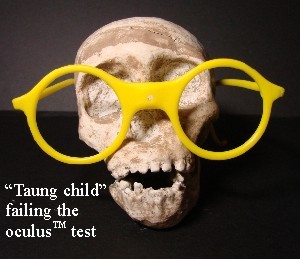 Austalopithecus africanus is listed on wikipedia (that wonderful treasure trove of anti-creationist misinformation) as ancestral to humans… but the chart in SciAm has it as a dead-end branch, just like garhi. Why? In fact, on the wikipedia page, they show the “Taung child” (a skull of which I recently aquired a cast for the Creation Science Museum of Canada), which is nothing more than the skull of a baby chimp.It’s interesting to note that when the discoverers first reported on this skull, its cranial capacity (the space for the brain) was quite large at 510 cubic centimeters.Later reassessments of that capacity dropped it down to 407cc’s! Why the drastic change of over 20%? Because brain capacity plays a role in evolutionary thinking: To an evolutionist, a larger brain equals more intelligence. (See Duffertt’s article in the Sept 1983 CRSQ)
Austalopithecus africanus is listed on wikipedia (that wonderful treasure trove of anti-creationist misinformation) as ancestral to humans… but the chart in SciAm has it as a dead-end branch, just like garhi. Why? In fact, on the wikipedia page, they show the “Taung child” (a skull of which I recently aquired a cast for the Creation Science Museum of Canada), which is nothing more than the skull of a baby chimp.It’s interesting to note that when the discoverers first reported on this skull, its cranial capacity (the space for the brain) was quite large at 510 cubic centimeters.Later reassessments of that capacity dropped it down to 407cc’s! Why the drastic change of over 20%? Because brain capacity plays a role in evolutionary thinking: To an evolutionist, a larger brain equals more intelligence. (See Duffertt’s article in the Sept 1983 CRSQ)
Bottom line: africanus was originally believed to be bipedal, we now know it wasn’t, it’s just an ape. The oculusTM test confirms its ape characteristics as well.
- Paranthropus aethiopithecus: Besides being so ape-like that an amateur can see it (did I mention it fails the oculusTM test?), see that prominent, bony ridge down the back of the skull? That’s characteristic of male gorillas. Also notice again that P. robustus and P. boisei are off on dead-end streets again? Yup, that’s because they’re so ape-like, that even the evolutionists no longer consider them ancestral to humans. They are all apes, nothing more, nothing less.
- Homo/Kenyanthropus rudolfensis (skull KNM-ER 1470) was originally classified as Homo, that is, on the way to becoming human. You’ll notice it’s now been reclassed as Kenyanthropus? You’ll also notice how there’s a dashed line between it and platyops? You also notice that the evolutionary thinkers don’t even have a “best guess” as to where platyops came from? The dashed line indicates that they question the relationship between rudolfensis and platyops! Smthsonian and wikipedia still have it listed in the Homo category. One just has to sit there and scratch his head, wondering what on earth they are doing with this skull. But then, take a look at the history of it, and you’ll being to understand why in “The Rise and Fall of Skull 1470”: http://www.trueorigin.org/skull1470.aspIf you get the chance, you certainly want to read the appendix in Lubenow’s book (mentioned below). This skull provided an excellent opportunity to demonstrate how subjective the “scientific method” of radiometric dating is.
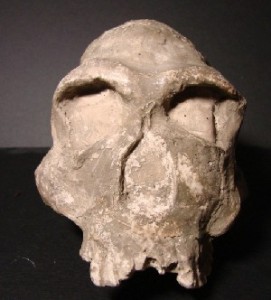 Homo habilis: Skull 1470 was originally classed as habilis, because what was interpreted as stone “tools” were found nearby.Now that 1470 is no longer grouped with habilis, we’ll look at the other habilis fossils, like KNM ER 1813 (on right, also a recently aquired cast for the Creation Science Museum of Canada), OH 7, OH 24 “Twiggy”, and KNM ER 1805. Originally habilis was thought to be the direct ancestor of Homo erectus, until last year. As noted in this BBC article, two fossil discoveries have altered that view, and has led to wild speculation – even on the sex lives of habilis and erectus!Yes, some think you can figure all that out from a fossil.
Homo habilis: Skull 1470 was originally classed as habilis, because what was interpreted as stone “tools” were found nearby.Now that 1470 is no longer grouped with habilis, we’ll look at the other habilis fossils, like KNM ER 1813 (on right, also a recently aquired cast for the Creation Science Museum of Canada), OH 7, OH 24 “Twiggy”, and KNM ER 1805. Originally habilis was thought to be the direct ancestor of Homo erectus, until last year. As noted in this BBC article, two fossil discoveries have altered that view, and has led to wild speculation – even on the sex lives of habilis and erectus!Yes, some think you can figure all that out from a fossil.
Habilis is nothing more than an ape. Check out one of my favourite “ScienceAgainstEvolution.org” pages, on habilis:
http://www.scienceagainstevolution.org/v4i6f.htm as well as Woodmorappe’s excellent article compiling characteristics of multiple “species” of hominds:
http://www.answersingenesis.org/tj/v13/i2/human_fossils.asp- Homo ergaster is human. It should be noted there are several ergaster fossils, but the size and cranial capacities fall within the variations observed within humans. You can check out a photo here of one ergaster skull, and even with his broken nose bone ridge, he would probably still pass the oculusTM test. Yes, he has very large brow ridges, but that is also present in modern humans! Much is made of prominent brow ridges, but the fact of the matter is, if you look around, you can probably see people in public with brow ridges like that. (Just don’t laugh, and don’t tell them I wanted their picture!) The heavy (“robust”) brow ridges are simply from a tough diet. The muscles from the jaws go up and over the skull, and a tough diet builds both muscle and the bony ridges above the eyes.
- Homo antecessor doesn’t have much left over from his final, very bad day. Take a look here. From what little that can be interpreted from these rather sparse fossils, it does appear to fall within the range of modern human characteristics. You can’t really say a whole heck of a lot about antecessor.
- Homo heidelbergensis is the same build and has the same jaw as modern humans. It has a cranial capacity perfectly within the modern human range. This is evidence of evolution?
http://creationwiki.org/Homo_heidelbergensis - Homo neanderthalensis (shown above passing the oculusTM test with flying colours) was not human. It was superhuman. Neanderthal man had a larger cranial capacity than we do – so … were they smarter than us? Another excellent article by the folks at Science Against Evolution: http://www.scienceagainstevolution.org/v12i2t.htm but I also need to steer you towards Dr. Pitman Hey’s excellent article on the comparison of human and Neanderthal DNA. The skinny: Modern humans are typically more different from each other, genetically speaking, than the neanderthal is from the average, modern human!
About 2/3 down the page: http://www.detectingdesign.com/earlyman.html - Homo erectus. Originally thought to have evolved from habilis… until erectus fossils were found in the same layer and not far away from habilis fossils. I don’t think I need to say much. There is nothing un-human about these fossils! So again I ask, “How does this help evolution?”
- Homo floresiensis is the most recent find, and certainly is stirring up debate. You may have heard of this “hobbit” fossil, as it was nicknamed because it was only about 1 meter tall. Found in a cave on the island of Flores, Indonesia, in 2004, these small skeletons are typically 1 meter tall. Some evolutionists have suggested these are simply the remains of humans with genetic disorders like microcephaly, or perhaps poor nutrition. The discoverers are claiming they were a separate species from modern humans.
At this point, there’s not a heck of a lot to say. From what very little I’ve been able to see, I haven’t been impressed with the arguments that they’re not human. As it is, even the evolutionists are up in arms about the interpretation of these bones (which aren’t fossilized). The apparently tools found in the cave appear to be appropriate for a 1 meter tall human, which seems to lend credence that the “hobbit” was an intelligent being. Frankly, even if it turns out to be another “species,” I fail to see how this supports evolution.
Whadabout the ape fossils?
After all of this, have you noticed that evolutionists never seem to find any fossils from apes? It’s intriguing to note that all of these “ape-like” human ancestors are being found, but no ancestors of apes! Coincidence?
 Further reading:
Further reading:
I’d highly recommend Marvin Lubenow’s book on the subject of supposed “ancestral human fossils.” It is easy reading, and chock full of good history and analysis of many fossil hominids.

